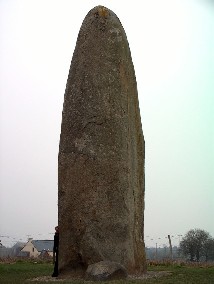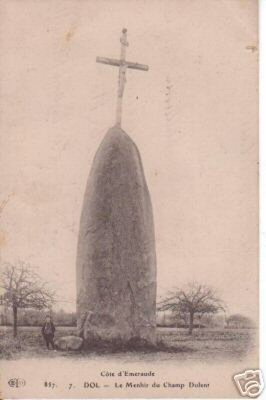|
Location:
D795, Nr Dol, Normandy/Brittany,
France. |
Grid Reference:
48� 32' 10.17" N, 1� 44' 59.7" W
|

 Dol de Breton:
(Menhir de Champ-Dolent, Menhir of the 'Field of Woe').
Dol de Breton:
(Menhir de Champ-Dolent, Menhir of the 'Field of Woe').
Currently the largest standing stone in France.
The Dol-de-Breton stands on
the borders of Normandy and Brittany.
The nearby 'Mont Dol' is the place
where
St. Michael is said to have
fought Lucifer.
The
syllable
'Dol'
is also used in the Breton word 'Dolmen', which means 'stone-table'.
It has been dressed (from pink
granite) so that it is
almost square at the bottom.
The
menhir stands 9.5m high with an
estimated weight of 150 tons.
(4)
The menhir of Champ Dolent is
the largest menhir erected in Brittany. Located on the city
of Dol-de Breton, it measures nearly 10 m high. It is
registered as a monument historique by the French Ministry
of Culture since 1889. (2)
The menhir
was for along time surmounted by a large crucifix.
Mont Dol:
This small granite
outcrop has been occupied since prehistoric times � flint implements
have been unearthed alongside the bones of mammoths, sabre-toothed
tigers and even rhinoceroses. Later on, it appears to have been used
for worship by the druids, before becoming, like
Mont St-Michel, an island
monastery, all traces of which have long vanished. A plaque
proclaims that visiting the small chapel on top earns a papal
indulgence. (1)
Dol cathedral was built directly between the Dolmen and Mont-Dol in the middle ages, at around
the same time as the 'Abbey' on Mont. St. Michel. (building began in the
11th century, and has been altered on several occasions)

The small shiny stone at the bottom of the menhir
is not the same stone as that of the menhir (Photo left).
It has been there for a long time as attested by the photos
below.
Chronology:
Although Mont Dol would have
been an island in prehistoric times, both the menhir and the nearby 'Mont-Dol' have roots that trace back to Neolithic
times.
Archaeoastronomy:
The Dol de Breton is a part of a solar alignment running between
Mont St. Michel, (which
is clearly visible from the top of Mont Dol), and
D' Avranches. The three sites align so that the rising sun
on the 8th of May (the spring festival of St. Michael), rises over
D' Avranches, follows the axis of the Abbey on Mont St. Michel, then passes
over Mont Dol and finally the Dol de Breton.

The Mont St. Michel
Alignment is crossed over by the St
Michael's leyline which runs across Europe.
(More about
Archaeoastronomy)
Legends:
Several legends relate to Champ Dolent and the
menhir.
The name
"Champ Dolent"
was appointed to more than one place, and it reminds us that this
place was held after fighting and confrontation, and where the
victims' bodies were buried.
The debris of weapons often found in
these places confirm this theory.
One legend tells us also that the menhir
Champ Dolent fell from the sky or that the sky was so horrified, it
dropped it to separate the armies of two brothers engaged in a bloody
battle on this ground.
The battle was so terrible that it gave
the name "field of
pain" to this place after witnessing
this bloody massacre.
It is said by the way, that so much
blood was paid for in the outpouring during this fight that the mill
valley ran non-stop. The legend ends by saying that each century, the
menhir sinks into the ground a few millimetres.
When the menhir has been completely
buried in the soil, this will be the end of the world.
Another version of the legend specifies
that whenever a person dies, the menhir sinks into the ground. Its
full submergence signifies the end of the world. it .
Another legend includes
Mount Dol.
It is said that one day, Satan saw
Saint-Samson building a cathedral on Mount "Dol" from the surrounding
marshes.
The rise of a religious building on an
ancient site made the fallen angel indignant, he took a rock of Dol
and threw it to the Cathedral in order to destroy it.
The rock destroyed the upper part of the
north tower (still today, this tower is missing) and fell in a field.
Lewis Spence said of
it:
'A strange
legend is connected with this menhir. On a day in the dark,
uncharted past of Brittany a fierce battle was fought in the
Champ Dolent. Blood ran in streams, sufficient, says the tale,
to turn a millwheel in the neighbourhood of the battle-field.
When the combat was at its height two brothers met and grappled
in fratricidal strife. But ere they could harm one another the
great granite shaft which now looms above the field rose up
between them and separated them'.
(3)
Old Photographs
of the Menhir de Champ Dolent.


|




